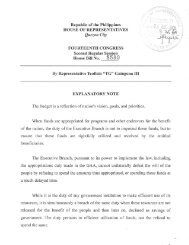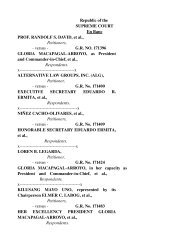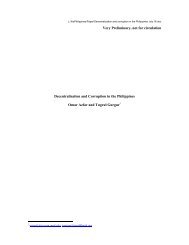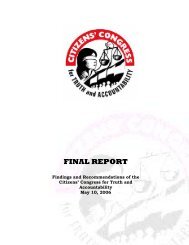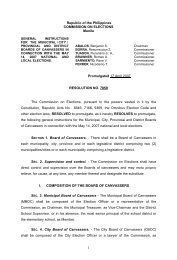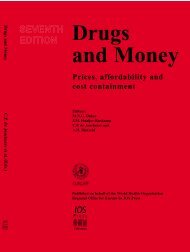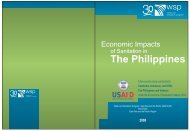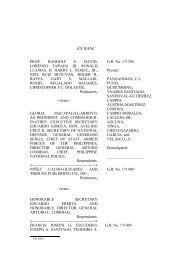i Report Issue No. 3 2005 - Philippine Center for Investigative ...
i Report Issue No. 3 2005 - Philippine Center for Investigative ...
i Report Issue No. 3 2005 - Philippine Center for Investigative ...
You also want an ePaper? Increase the reach of your titles
YUMPU automatically turns print PDFs into web optimized ePapers that Google loves.
TWO AT EDSA<br />
‘When the wheels of<br />
history turn, you hardly<br />
expect the world to<br />
turn upside down’<br />
ED LINGAO<br />
DURING THE last<br />
Edsa anniversary<br />
celebrations, we<br />
thought of having<br />
a reporter find out<br />
what the younger<br />
generation knew of Edsa.<br />
Some excerpts:<br />
Question: What was Edsa ’86<br />
about?<br />
Answer: …it was a massacre,<br />
right?<br />
Question: What was Edsa ’86<br />
about?<br />
Answer: A strike?<br />
Question: When did the 1986<br />
Edsa revolution occur?<br />
Answer: Sometime in 1989… Oh<br />
no, it was in 1990.<br />
The event that made a generation<br />
so proud to be Filipino, made<br />
us stand straighter when we heard<br />
the national anthem, that one event<br />
that defined us in the eyes of the<br />
world, may as well have been,<br />
<strong>for</strong> a different generation, another<br />
episode of “Wow Mali!”—except<br />
this was a lot funnier than anything<br />
Joey de Leon could cook up. It<br />
would have been hilarious had it<br />
not been so sad.<br />
What makes it so painful is the<br />
fact that these interviewees were<br />
not comedians or bums hanging<br />
out at the neighborhood sari-sari<br />
store. They were Metro Manila<br />
college students from private<br />
schools. These were the crème de<br />
la crème. One shudders at what<br />
the rest of the crop thinks.<br />
I was among those massed at<br />
Edsa in 1986, a dot among a couple<br />
million other Filipinos. I was<br />
still a junior at UP at the time, and I<br />
had come with a few of my college<br />
buddies. But we soon lost each<br />
other in the crowd and I found<br />
myself near some praying nuns.<br />
That’s when Times<br />
photographer<br />
Pete Reyes snapped that photo<br />
that would be the iconic image<br />
of that one hot Sunday afternoon<br />
in Ortigas when nothing mattered<br />
more than standing still.<br />
The expressions on the faces of<br />
the nuns froze a precious moment<br />
of terror and fright as the marines<br />
started the engines of their LVTs,<br />
those huge, boxlike amphibian<br />
tanks. Everyone sit, someone shouted,<br />
and everyone in front did. Some<br />
rushed <strong>for</strong>ward to put their hands<br />
against the hot metal, only to feel<br />
how frighteningly solid and heavy<br />
eight tons of armor must be. The<br />
marines gunned their engines, and<br />
the exhaust pipes spewed black<br />
against the sky. Suddenly, the tank<br />
jerked <strong>for</strong>ward, and the marine on<br />
top of the tank begged everyone to<br />
clear a path or be crushed under the<br />
tracks. People were screaming and<br />
crying. But the line stayed. The tank<br />
jerked <strong>for</strong>ward again, and we shut<br />
our eyes and prayed that the driver<br />
had children of his own. And still<br />
the line stayed.<br />
Nineteen years later, the line<br />
was broken beyond repair. In fact<br />
the line had changed so many<br />
times that it was hard to recall<br />
who stood with you then. Post<br />
Edsa, Cory went one way, Enrile<br />
went the other; the Marcoses came<br />
back, not to be prosecuted, but to<br />
Ed Lingao (in dark<br />
glasses) faced the tanks<br />
in Edsa 1. Above photo<br />
shows him posing in<br />
front of a tank while<br />
covering the Iraq war.<br />
be icons of the new young (“Aiii,<br />
ang pogi- pogi ni Bongbong! [Ay,<br />
Bongbong is so handsome!]”) or<br />
fashion statements. Imelda was<br />
allowed to be herself, which was<br />
perhaps as good a punishment as<br />
any. <strong>No</strong> one, whether coup plotter<br />
or plunderer or human-rights abuser,<br />
was sent to jail. Those rounded<br />
up were the usual suspects—the<br />
activists, the strikers, the eternally<br />
discontent. It all sounds so trite,<br />
yet it all sounds so true. Colors<br />
changed so blindingly fast, and the<br />
rainbow coalition soon saw <strong>for</strong>mer<br />
street parliamentarians rubbing<br />
elbows with some of the biggest<br />
Marcos cronies. Ninoy’s Laban became<br />
the LDP, which was soon led<br />
by those who laughed in Ninoy’s<br />
face a decade be<strong>for</strong>e. Later, the parliamentarians<br />
would become the<br />
cronies, and the dictator’s cronies<br />
would act like persecuted activists.<br />
When the wheels of history turn,<br />
you hardly expect to see the world<br />
turn upside down.<br />
We were under no illusion<br />
that the revolution was over<br />
when Marcos left. But we never<br />
thought that people would <strong>for</strong>get<br />
EDSA. Sometimes it seems they<br />
never even heard of it at all.<br />
The author is a TV journalist who<br />
covered the Iraq war and the conflict<br />
in Mindanao. He is now head<br />
of news operations of ABC-5.<br />
30 PHILIPPINE CENTER FOR INVESTIGATIVE JOURNALISM I REPORT



